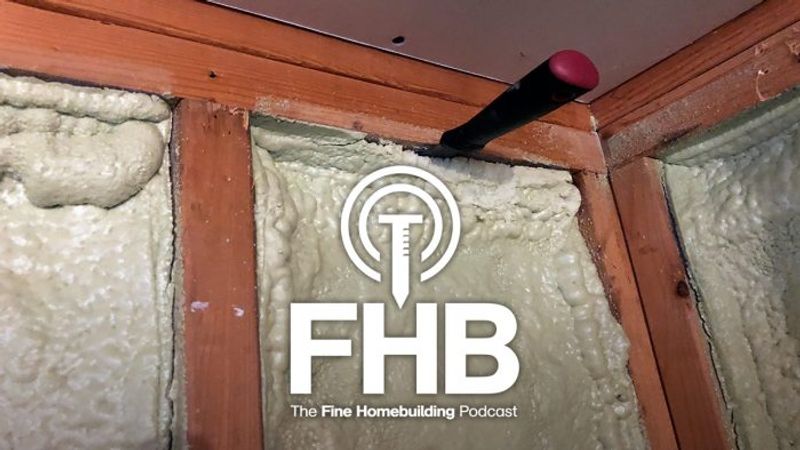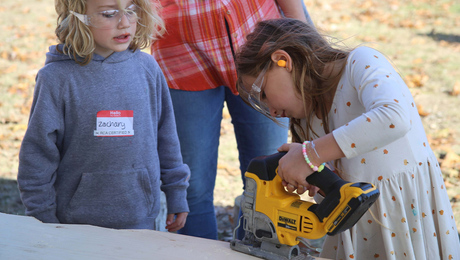Podcast 275: Making do without PT, Wasting Paint, and Staging High Work
Rob, Kiley, and Patrick hear from listeners about faulty spray foam and favorite tools before taking questions on building a shed without PT, wasting paint using a sprayer, and staging high work.

Follow the Fine Homebuilding Podcast on your favorite app. Subscribe now and don’t miss an episode:
 |
 |
Help us make better episodes and enter for a chance to win an FHB Podcast T-shirt:
www.finehomebuilding.com/podcastsurvey
Anderson shares photos of shrunken foam and asks about drawer slides. Keiran talks about some favorite tools. Jesse asks how to waste less paint when using a sprayer. Brian wants to finish his basement ceiling but worries about access to pipes and wires. Jean-Charles asks about working safe on steep roofs.
Editor Updates:
Rob’s storm damage
Jeff’s storm damage
Patrick’s storm damage
Kiley’s projects and articles
 |
 |
 |
 |
 |
 |
 |
 |
 |
 |
 |
 |
Listener Feedback 1:
Anderson from Londonderry, VT writes: Hello Podcast crew! I have been an avid listener since the early days – thank you for such great content!
I was listening to episode 269 and you were all talking about spray foam shrinkage and if spray foam is a good air sealer. I think I have the answer for you!
I had my garage/shop spray foamed about 3 years ago and have yet to cover it up. In many of the stud bays the spray foam has shrunk away from the stud, sometimes as much as 3/16 of an inch. I don’t want to rush putting up wall material and this is a concern for me. The crazy in me is thinking of installing 1/2″ rigid foam over the studs, taping the seams and then putting up my wall material. What do you think?
See the photos below that show the shop and spray foam issues. Please don’t pay attention to the loose wires in the shop – I’m in the middle of a renovation and the wires will be cleaned up and run through conduit soon!
 |
 |
 |
 |
 |
 |
I have a question as well –
Drawer slides are my kryptonite. I have been a carpenter / handyman for the past 10 years and drawer slides are always a challenge. Do you all have suggestions for drawer slides – brands? Certain styles that are easier to install? Are there products that make it easier? I’ve seen Rockler’s drawer jig but I’m always a little skeptical of $20 plastic jigs. Let’s talk drawers!
Related Link:
Listener Feedback 2:
Keiran Toronto, Canada writes: Hi FHB crew, I listened to podcast 269 and thought I could share some of my favourite and somewhat unique remodeling/carpentry tools. I was excited to talk about my Japanese cat’s paw, but Patrick beat me to the punch. Rats!
In no particular order, these are a few of my favourite hand tools that I wouldn’t want to go to work without.
 |
 |
 |
1. Spring tools nail set: This is a fantastic tool. It can be difficult at times to set a nail in tight quarters, especially if you’re precariously balanced atop a ladder and you’re trying to not only manage a standard nail punch, but also a hammer and your footing on the ladder. This tool works with a spring between two tapered steel ends. You simply hold one end on the nail you intend to set, pull the other end away from the nail, and release it. It’s an absolute pleasure to use. A bonus feature is that it can be used to remove hinge pins from doors. They make one specific for doors only, but I find I can use the small end of the nail set and it works just fine.
2. Winbag Air Wedge: Another great tool. These are an easily inflatable reinforced bag that can lift up to 300 pounds (according to the website; I haven’t actually tested mine for capacity yet). These are very handy for hanging doors, levelling/installing appliances, installing built in cabinets, and installing windows.
3. Right Angle Drill Attachment: This was a great addition to my tool arsenal. Mine is the dewalt brand, however there are a few different companies that make them. It can be used with an impact driver or a drill and is great for getting into tight spots where your drill just won’t fit. My favourite thing about it is how little space it takes up. I use it often, but not often enough to justify buying a right-angle drill.
Related links:
Question 1: Can I build a durable shed floor without pressure-treated lumber?
Geoff from Jamestown, NC writes, THIS HAS NOTHING TO DO WITH AIRSEALING…sorry 🙂
I’m building a shed based on the FHB Sketchup model that Justin created (10′ x 16′). My gravel just showed up today so I can probably start the layout and framing the floor next weekend. However, finding PT lumber is very difficult now. I was wondering if it’s possible to do this without PT? I was thinking of using regular lumber, but then covering the rim joists with flashing tape to protect them from splash back. Underneath the floor I could fasten some exterior plywood and possibly tape the seams, although I’m not sure the tape would be necessary.
Putting the sheathing on the underside of the floor will be hard but I think I could frame the floor in two halves. Then flip one upside down on top of the other, attach the plywood then flip it back onto the blocks. Repeat for the other side.
Is this a crazy idea?
Related links:
- Build a Timber-Frame Shed
- What’s the Difference: Pressure-Treated Lumber
- FHB Forum: Alternatives to pressure treated lumber
Question 2: What should I do with the paint left in the hoses of my spray rig?
Nolan writes, Hi FHB, I have recently started using a paint sprayer for some small DIY projects. I’ve noticed that through the process of priming and flushing the sprayer there is excess paint in the bottom of the bucket. While I’ve gotten better at producing less of this waste, it still seems like there is more paint then should be put down a drain, but it might add up to the paint on a couple of rollers so is it ok? I can’t imagine pros going to the proper facility every time they use their sprayer. But it also does not seem right to dump it down the drain. Would it be best to use in a drying agent like litter; let it harden and scrap it out of the bucket? Or is it best to just use rollers unless it’s a large multi-hour/day project? For example if I was trying to paint the whole house in a day the waste would be less then if I was doing a room every couple of days. Any advice on the best environmental or practical solutions would be appreciated.
Thanks!
Related links:
It is a Graco Magnum x5 Airless Sprayer with a 25 ft 1/4” hose. I use two 5-gallon buckets, one for clean water that I use to flush out the priming fluid when I start and when I flush out the paint during clean up. The second bucket is for waste. During priming I try to be careful to spray as little paint in the waste bucket and during clean up try to get as much paint out of the hose and back into the paint can before I flush the hose and sprayer. But there is always what seems to be a significant amount of paint in the bottom of the waste pail if I had to guess maybe a 1/8” of paint. The sprayer manufacturer says paint can sit in the sprayer for a day or two which would allow for fewer flushing and primings, but in Phoenix things tend to dry pretty quick so I’d be nervous it would ruin the sprayer. In a previous podcast you mentioned to not clean the roller in the sink to just throw them away. I would like to dispose of the paint in an environmentally friendly way because it feels wrong putting it down the drain. I’ve tried to google it but only come up with answers on how to dispose of large amounts of paint.
Question 3: How should I insulate, soundproof, and finish my basement ceiling?
Brian writes, Hello air sealing podcast!
Hope all is well. I am re-finishing about half of my basement in a 1956 cape in Portland Maine. I am developing the insulation plan for the walls, but am at a loss for the basement ceiling/house floor. In the original “finish” it was a mix of fiberglass drop ceiling and stapled fiberglass tiles that left only about 6′ 2″ of height and for future planning purposes there is a good chance my 6′ father (and 4′ 11″ mother) will be residing there at some point in the not so distant future.
My conundrum is balancing access to electrical/plumbing and sound reduction (board sheathing under hardwood floors) with the height restrictions. I originally intended to double up on fire rated 5/8 drywall for optimal sound reduction, but I’m worried about access in the future, but am also worried about losing 3-4 inches in height to a new drop ceiling.
My plumbing and electrical runs are fairly concentrated in a few areas, im wondering if there is a detail you’ve seen/used that would allow for access when needed but won’t be a huge sound penalty?
Is there a good workaround or am I just delaying the inevitable drop ceiling and should just hope my dad shrinks another inch (he was 6′ 2″ at one point) before they eventually reside in my subterranean lair?
Related links:
- Basement Ceilings: Drywall or a Drop Ceiling?
- Soundproofing: A Successful Hybrid Approach
- Multilayer Drywall Applications
Question 4: What’s the best way for me to safely work on my roof and siding?
Jean-Charles writes, Hello, to everyone. Your program is my constant companion as I rebuild what I consider to be the very first McMansion dating from the 1700’s.
Help! I work mostly by myself, the roof is steep 60° the siding, gutters, and roof all need work. What is a safe set of gear to get the job done?
Buy? Rent? Scaffolding? Ladder jacks? Home-made? The gear has to be light enough for one-man setup.
What would you choose?
I have commercial (flat roofing experience, just not 60°)
Thanks for your great program!!
Related links:
- A Practical Guide to Fall Protection
- Safer Scaffolds for Quick Jobs
- What’s the Difference: Wooden Scaffold Plates
- Mechanical Advantages
 End Note:
End Note:
Help us make better episodes and enter for a chance to win an FHB Podcast T-shirt:
www.finehomebuilding.com/podcastsurvey
If you have any questions you would like us to dig into for a future show, shoot an email our way: [email protected].
If we use your question we’ll send you a FHB Podcast sticker!
FHB Podcast T-shirts!
Represent your favorite podcast! Available in several styles and colors. Made from 100% cotton. Find the Podcast t-shirt and more cool products in the Fine Homebuilding Store.
This episode of the Fine Homebuilding podcast is brought to you by Sherwin Williams.
Supporting your business is their business at Sherwin-Williams®. With outstanding paint and color solutions and industry-leading product innovation, they’ll help you deliver more per square foot—and exceed homeowner expectations. Sherwin-Williams is there through every step of the process to help you find the best product for your project, and provide color solutions to make your homes stand out. When pros needs pros, Ask Sherwin-Williams™.
Visit buildersolutions.sherwin-williams.com for more.
Fine Homebuilding podcast listeners can now get 20% off anything in the Taunton store, including the The Visual Handbook of Building and Remodeling, 4th Edition.
Use the discount code FHBPODCAST to take advantage of this special offer.
We hope you will take advantage of a great offer for our podcast listeners: A special 20% off the discounted rate to subscribe to the Fine Homebuilding print magazine. That link goes to finehomebuilding.com/podoffer.
The show is driven by our listeners, so please subscribe and rate us on iTunes or Google Play, and if you have any questions you would like us to dig into for a future show, shoot an email our way: [email protected]. Also, be sure to follow Justin Fink and Fine Homebuilding on Instagram, and “like” the magazine on Facebook. Note that you can watch the show above, or on YouTube at the Fine Homebuilding YouTube Channel.
The Fine Homebuilding Podcast embodies Fine Homebuilding magazine’s commitment to the preservation of craftsmanship and the advancement of home performance in residential construction. The show is an informal but vigorous conversation about the techniques and principles that allow listeners to master their design and building challenges.
Other related links
-
- All FHB podcast show notes: FineHomebuilding.com/podcast.
- #KeepCraftAlive T-shirts and hats support scholarships for building trades students. So order some gear at KeepCraftAlive.org.
- The direct link to the online store is here.


























View Comments
I do enjoy the podcast and feel that I'm learning something quite often. Then, I hear the explanation of why generators are loud. 'they are little motors and in order to make enough, uh you know, power they have ta spin fast and loud' Over simplification at best. Generators are not loud by necessity. The generator I have is not loud, not overly large, and can power my well pump. https://www.briggsandstratton.com/na/en_us/product-catalog/generators/portable-generators/q6500-quietpower-series-inverter-generator.html